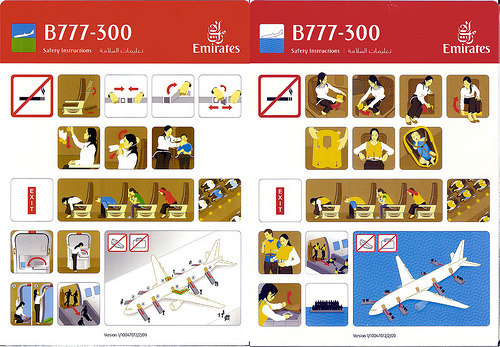I fly between 50,000 and 100,000 air miles per year on average. So I have the opportunity to listen to at least one hundred of those pre-takeoff, air safety instruction announcements from various flight attendants on different airlines. Sadly, most of these speeches are uninspired, monotone recitals of the legally-engineered scripts produced at headquarters. Sometimes I wonder whether anyone at the airline has actually listened to these announcements in the past five years when phrases like please put away all portable CD and DVD players are included. Seriously, does anyone really carry a CD player on a plane any longer?
The captain usually comes on before the safety announcement encouraging people to put down their reading materials, stop reviewing their email and give the flight attendants a few minutes of their undivided attention. The appeal from the flight crew is often genuine, but is followed by a weak transition to a seemingly-apathetic flight attendant who simply reads the script verbatim without the least bit of improvisation or emotion. As a result, the majority of the passengers carry on reading the newspaper, typing last minute emails or trying to filter out the loudspeaker and fall asleep. And who can blame them really – during weekdays when I often fly the plane is half-full with frequent fliers who have heard the safety speech hundreds of times before. While these road warriors may have heard they did not listen and consequently may not be prepared to respond in the event of an emergency.
Flight Safety Card from Emirates Airlines
But once in a while you encounter a flight attendant that loves their job and has taken the extra time to customize the safety speech in an imaginative and engaging way. And everyone on the plane stops to listen. In fact, as the speech goes on they begin to hang on every word. Some people have even begun to capture these on camera. Below is one example.
I find many corporations in the tech sector making the same mistakes. They spend millions of dollars on marketing programs, interrupting decision makers to deliver a message that is quite frankly stale and overplayed. Our products leverage SaaS, cloud computing, big data, mobile and social networking. Yawn. Our “solutions” are market leading, best-of-breed, next generation, world class, mission critical, groundbreaking and user friendly. Double Yawn. We can help you cut costs, improve customer satisfaction, reduce risk and accelerate revenues. Aren’t these the same big promises everyone else says? If the promises are really true then some detail on how and why might be compelling.
Mission and vision statements often fall victim to the same problem of undifferentiated messaging. Does your mission statement state that you want to have the most innovative products, the most talented employees and the most satisfied customers? So does the fast food restaurant down the street! Doesn’t every company want those things? The message is undifferentiated and so generalized that it gets ignored by the employee base to who it is targeted.
To stand out from the crowd, your messaging needs to be differentiated. It cannot use the same-old-same-old hyperbole that everyone else is using. You can achieve differentiation in your delivery model. For example, you could be humorous or sarcastic. Or you can mix things up with different choice of words. Instead of some ungenuine statement about customer service, use a phrase like Zappos does – “We Deliver WOW through service.” Instead of using the overplayed “innovation” word to describe your products use something like Apple’s does – “We believe that we’re on the face of the Earth to make great products.” Instead of the same half-hearted speech about hiring great employees, use phrases like we seek out employees who have a “missionary zeal in representing the company and its products.”
If the flight attendants can do it, so can marketers. Here is an example of an airline captain that substituted characters, locations and spacecraft from the Star Wars trilogy in his pre-flight announcement.










